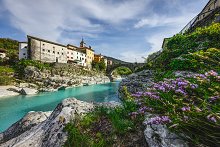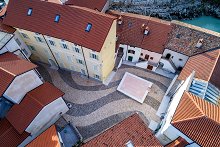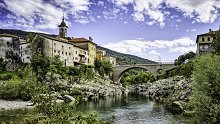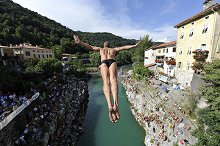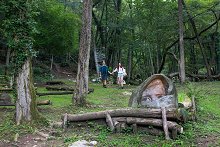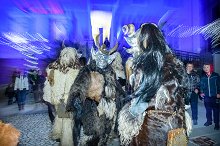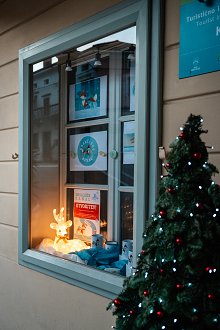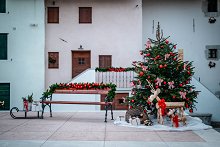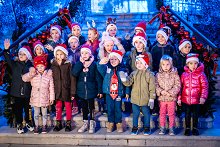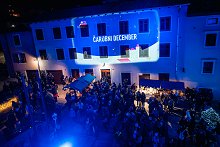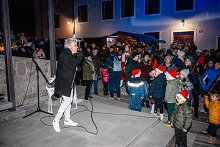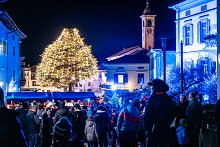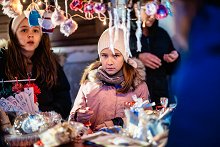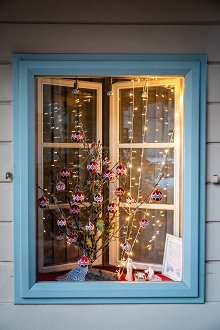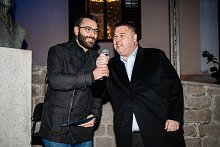Kanal
The Municipality of Kanal ob Soči lies in the Central Soča Valley and borders with Italy, with Friuli Venezia Giuglia to be exact. Right on the border flows the marvellous River Idrija. The area of the Municipality of Kanal ob Soči is divided into three geographical parts: the main part includes the Soča Valley, then there is the hill country which is the area of Kanalski Kolovrat in the West, and the third part is the Banjšice Plateau in the East.
Kanal
In view of its area (i.e. 147 square kilometres), the Municipality of Kanal ob Soči is considered as a big municipality, but the size of its population (i.e. 5.502) renders it a medium-size municipality. The Municipality is divided into eight local communities: Kanal, Deskle, Ročinj, Kambreško, Lig, Avče, Levpa and Kal nad Kanalom. The largest towns of the Municipality are Kanal and Deskle, each one of them having a population of cca 1.000.The remaining communities are mostly hamlets or just single and very small villages.






Today Kanal is the administrative centre of the Municipality of Kanal ob Soči. You can find the municipal building in Kanal, constructed by Max Fabiani.
In the old centre of the town is the Kontrada Square, where you can find a house in the Gothic style with the memorial room of Riko Debenjak and Josip Kocijančič’s library. Riko Debenjak’s Gallery is in the renovated defence tower.
In the very heart of the town, you can find Mary’s Church dating from 1431. The high altar is made out of Carrara marble. Apart from the church, there is also firstly, Neptune’s Fountain, constructed in 1815, secondly, Valentin Stanič’s bust – he was a clergyman and alpinist, and then finally a bust of Marij Kogoj, an expressionistic composer. In the vicinity, you can also admire the bust of the founder of the national library, Josip Kocijančič, and that of the painter Ivan Čargo.
The History of Kanal
Foto: Marko Puc Foto: Primož Kožuh
This Mediaeval town with its rich cultural heritage lies on the banks of the River Soča, which are linked by means of a wonderful two-arch bridge. The origins of the town lie in the flow of the River Soča. In the area of Petrucka, it is said that a bridge have existed already in Roman times, and it is here that the settlement would have originated. Kanal and its area were first mentioned in a document from 1140, where it was written that the Count of Gorica, Henrik Ist, gave the feudal estate of the area from Ročinj to Kanal, to the cloister in Rožanc near Udine. Kanal developed into a settlement surrounded by walls. The population of the area made their living from handicraft and trading. In the Middle Ages, Kanal belonged to the Count of Gorica and to the patriarch of Aquileia. After 1500, the regime changed many times: from the Count of Rabatta (from 1624 to 1794) to the Count of Coronini (from 1794 onwards).
From the mid-fifteenth century onwards, the area was invaded by the Turks and Kanal provided the defence. The Turks invaded in the years 1469, 1477 and again in 1488. Bad times continued even after the Turkish invasions. In the periods between 1508 and 1515, and 1615 and 1619 war between Austria and Venice broke out. Even though Venice succeeded in taking control of Kanal on two occasions, it had to withdraw from Kanal later on. Following this, comes the time of the Illyrian Provinces (dating from 1809 to 1813) and the arrival of Napoleon, who also stayed in Kanal. He spent a night in the Kanal Castle, which unfortunately has not survived to this day. Legend has it that his white, gold-shoed horse perished in the castle. The horse was buried in a place close to the castle, after which the fallow land took the name Konjevo. With regards to industry, Kanal began developing mostly with the arrival of the Italian weavers, who started a weaving business and spinning mill. With that, the number of local tradesmen increased. Cultural development and the desire for the development of the personal and national identity greatly increased as well. Various associations were established, the first one being the Reading Society, established in 1848, which was a precursor to the National Reading Society, the latter being officially established in 1867. Its members were mostly the Slovenians, who kept organizing different academic and social evenings in reading societies. Following that there was the Fire-Fighting Society, which had continually been playing an important role and was established from the original Firewatcher, which had been created in 1863. During the First World War, by order of Austrian authorities, Kanal was evacuated due to the Soča Front passing by there. Many houses as well as Kanal’s bridge, which was renovated for the last time after the First World War, was damaged and destroyed in bitter battles. After the War, the entire coastal area belonged to Italy, as did Kanal, which had still been a Municipality and as such, it had belonged to the province of Gorica. After the War, there were 714 inhabitants in Kanal, and 1.993 inhabitants in total including the surrounding areas.
During the two Wars, the tourism kept developing as well. They were mostly Italians who were willing to make excursions to the surrounding hills, which even nowadays offer many tourist attractions for either discovering or relaxing in the countryside. Shortly after the Second World War, Kanal did not belong to Yugoslavia due to the division of the coast into two zones. The A-Zone, including also Kanal, was under the Anglo-American government, while the B-Zone was under the Yugoslavian government. After the union of the Littoral to its native land in 1947, Kanal came under the new Yugoslavian government as well. Kanal kept the status of a municipality up until 1962, when a new municipal reform resulted in Kanal becoming part of the Municipality of Nova Gorica. Kanal only became an independent municipality again in 1994.
Today Kanal is a modern place, which, apart from various, well-developed small businesses, offers great attention to the development of tourism. Thanks to its unspoilt environment and marvellous surrounding hills, it offers many possibilities for either relaxation or discovering new paths, new people, customs, culture and history.


Kanal’s Bridge



Kanal's Bridge, which was made of wood at first, was built in 1580. Throughout the history, it was demolished and reconstructed many times. The French, advancing towards Austria, destroyed it for the first time. Of course, the bridge was reconstructed and then, after French’s leaving, it was destroyed again. Thanks to Valentin Stanič (a priest, mountaineer, doctor, typographer and the founder of the school in the village of Banjščice), the bridge was reconstructed again in 1816. After that, the war settled the fate of the bridge. On 25th May 1915, the bridge was blown up, while in 1920, it was reconstructed again, and such bridge has preserved up to this day. The bridge was spared from destruction in the Second World War.
Kanal’s bridge is certainly the representative symbol of the town of Kanal, as well as a place that is worth seeing. It arouses the attention of many artists and visitors from far and wide. The scenery of the place with its wonderful bridge is represented in many paintings. The bridge, in fact, is the place that attract visitors' attention, for several summertime traditional events, such as popular diving from the bridge.
St. Mary of the Assumption Church



The church is situated right in the place, where pilgrim’s church used to be. Three-part presbytery with an arch in a star like ribbed form is thought to be, as far as its engraved date on the pillar is concerned, the oldest one of this type in Slovenia. The aisle in the Baroque style with its monumental Palladiev’s façade was built between 1787 and 1795. The higher marble altar was built in 1760 by the stonecutters from Gorica, whereas the lateral altars were built in 1662 and 1689. The fresco representing the Assumption of St. Mary, which is on the aisle ceiling, was produced in 1931. The vaults that date back to the same time as there was still a cemetery in the proximity of the church have also been preserved.
Cavity with statue - "Lurd"
Since inhabitants of Kanal remember, there was a natural cave in the rock. Mrs. Ravnik who was from a wealthy and respected family from Kanal, went in 1934 on pilgrimage to Lurdes (France), where she noticed an amazing similarity of Lourdes cavity to cavity in Kanal. After she returned from the pilgrimage, she communicated with the priest from Kanal (Monsignor Venceslav Bele) and proposed to renovate the cavity in Kanal, while she bought a statue of St. Mary of Lourdes. The priest has agreed and in 1934 cleaned up the cavity and statue was solemnly carried in and blessed. The statue remained intact even during the war. Cavity is still regularly maintained and decorated.
Neptune’s Fountain
Neptune's Fountain was made in 1815 with the help of the Count Coronini. It is believed that it is a work by the sculptor M. Chierigin from Padova. In the past, it was used for water collecting. The women used to take the water from this fountain with water containers made of wood. Informally, the locals from Kanal used to name the fountain Matija. At first, the fountain was situated on the opposite side of the road. Only in 1937, it was moved to the place where it is situated still today.
The Gothic House is situated in the immediate vicinity of the Riko Debenjak's gallery. It is built in the Gothic style in the 11th century. Inside the house there is a library. In the upper and lower floors of the house there are rooms where various social meetings take place.
Kanal's Castle
 Unfortunately, there is only history about Kanal’s Castle that has preserved. There are no written sources about the castle, even though it was mentioned in a document from
Unfortunately, there is only history about Kanal’s Castle that has preserved. There are no written sources about the castle, even though it was mentioned in a document from  1264. After having changed many owners, in 1624, the castle became the property of Count Rabbata, Sirs from Kanal. After their death, the castle became the propriety of the Count Coronini, who later on sold the castle to the French Duc de Blacas and their co-owners. That happened in 1830. The new proprietors transformed the castle into a business palace, and then, in 1903, they resold it again to the Count Coronini. Up to the First World War, the Austrian Seventh hunting battalion used to live in this place, but later on its members were sent to the front. When Italy declared war to Austria, and the front line approached Kanal, Italian grenades destroyed the castle.
1264. After having changed many owners, in 1624, the castle became the property of Count Rabbata, Sirs from Kanal. After their death, the castle became the propriety of the Count Coronini, who later on sold the castle to the French Duc de Blacas and their co-owners. That happened in 1830. The new proprietors transformed the castle into a business palace, and then, in 1903, they resold it again to the Count Coronini. Up to the First World War, the Austrian Seventh hunting battalion used to live in this place, but later on its members were sent to the front. When Italy declared war to Austria, and the front line approached Kanal, Italian grenades destroyed the castle.
After the First World War, the architect Nibrant restored the castle and changed it again into a business palace. Later on Nibrant went bankrupt, and the castle was sold at auction. After having been bought by an Italian from Udine, by Mr Del Valle, the castle finally was passed over to the people.
But today, almost nothing has been preserved from the castle. Despite that, in Kanal there is a part of the town, the Castle area, named after the Castle.
It is believed that Napoleon himself spent a night in the castle. In that very night his horse perished, and was thus buried in the vicinity of the castle. That is why this place was named after Napoleon's horse, i.e. Na Konjevem. It is after Napoleon that several bridges in the Municipality of Kanal were given the name.
Gallery Keramost
Klub keramikov Kanal boasts with more than twenty year's of activity and leaves its mark in Kanal. Gallery KERAMOST is located in the immediate vicinity of the stone bridge across the Soča, in the center of Kanal. Many exhibitions takes place in the gallery during the whole year.
Visit is possible by prior arrangement.
(Contact: Alenka - 00386 31 584 892, facebook - Klub keramikov Kanal)
Relaxation along the River Soča

Apart from many other ways of having fun in the natural beauty, during the summer, visitors can enjoy the relaxation and refreshment of swimming in Soča. In Kanal, there are many pleasant watering places; in fact, the sand beach is being regarded as a special place. During the summer, the water is just perfect for swimming and relaxing.
Apart from enjoying laziness and sunbathing, you can also admire old buildings with a Gothic house in the front, which, together with the bridge, form a marvellous picture of the small town of Kanal.
In the vicinity of the sand beach, there will be a proper place for camping that enables you to have a very nice holiday in touch with nature. Apart from this, you can also visit other attractions of the whole community.
Park Pečno
Park Pečno is a space where the forest is transformed into a natural venue for all sorts of recreational, cultural and educational outdoor activities. It is situated 600 metres from the centre of Kanal, alongside the road to Lig. The Park features a circular walking path offering a wonderful view of Kanal, a single track mountainbike trail and a forma viva sculpture garden. Entrance free of charge.
